External links
| This sports magazine or journal-related article is a stub. You can help Wikipedia by expanding it. See tips for writing articles about magazines. Further suggestions might be found on the article's talk page. |
| Categories | Scuba magazine |
|---|---|
| Frequency | 8 issues annually (once every 45 days) |
| Year founded | 1979 |
| Company | Asian Geographic Magazines Pte Ltd |
| Country | Singapore |
| Language | English |
| Website | www.scubadiveraa.com |
| ISSN | 0729-5529 |
Scuba Diver AustralAsia is a scuba magazine dedicated to underwater pursuits in the Asia Pacific region. The official publication of the PADI Diving Society in the region, Scuba Diver AustralAsia features stories on destinations, new equipment, the environment and marine science, interviews with iconic figures and underwater photography.
The title was first published in 1979 under the name Scuba Diver. In 2000, it was renamed Scuba Diver AustralAsia. The magazine is now published once every 45 days (eight issues per year).
As of April 2009, the magazine has a readership of 90,000 across 48 countries. [1] It is published by Asian Geographic Magazines Pte Ltd, which also publishes Asian Diver and ASIAN Geographic , a regional geographic magazine.
Scuba Diver AustralAsia organises dive expeditions, underwater photography workshops and photographic competitions on a regular basis.
| This sports magazine or journal-related article is a stub. You can help Wikipedia by expanding it. See tips for writing articles about magazines. Further suggestions might be found on the article's talk page. |
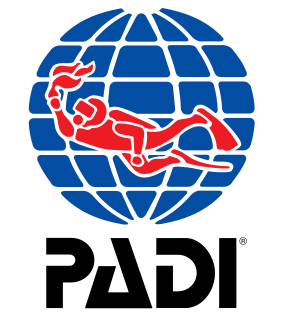
The Professional Association of Diving Instructors (PADI) is a recreational diving membership and diver training organization founded in 1966 by John Cronin and Ralph Erickson. Cronin was originally a NAUI instructor who decided to form his own organization with Erickson, and to break diver training down into several modular courses instead of the single universal course then prevalent.
The National Association of Underwater Instructors is a non-profit 501 (c) (6) association of scuba instructors. It is a recreational dive certification and membership organization established to provide international diver standards and education programs. The agency was founded in 1960 by Albert Tillman and Neal Hess. NAUI is headquartered in Tampa, Florida, US) with dive and member instructors, resorts, stores, service and training centers, located in Japan, South Africa, the Middle East, Europe, Brazil and the Pacific Rim.

Scuba diving is a mode of underwater diving where the diver uses a self-contained underwater breathing apparatus (scuba), which is completely independent of surface supply, to breathe underwater. Scuba divers carry their own source of breathing gas, usually compressed air, allowing them greater independence and freedom of movement than surface-supplied divers, and longer underwater endurance than breath-hold divers. Although the use of compressed air is common, a new mixture called enriched air (Nitrox) has been gaining popularity due to its benefit of reduced nitrogen intake during repetitive dives. Open circuit scuba systems discharge the breathing gas into the environment as it is exhaled, and consist of one or more diving cylinders containing breathing gas at high pressure which is supplied to the diver through a regulator. They may include additional cylinders for range extension, decompression gas or emergency breathing gas. Closed-circuit or semi-closed circuit rebreather scuba systems allow recycling of exhaled gases. The volume of gas used is reduced compared to that of open circuit, so a smaller cylinder or cylinders may be used for an equivalent dive duration. Rebreathers extend the time spent underwater compared to open circuit for the same gas consumption; they produce fewer bubbles and less noise than open circuit scuba which makes them attractive to covert military divers to avoid detection, scientific divers to avoid disturbing marine animals, and media divers to avoid bubble interference.
Scuba Schools International (SSI) is an organization that teaches the skills involved in scuba diving and freediving, and supports dive businesses and resorts. SSI has over 2,500 authorized dealers, 35 regional centers, and offices all over the world.
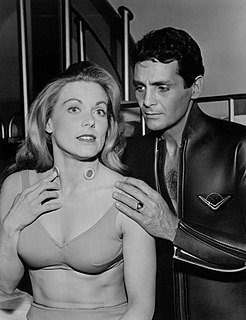
Rosalia (Zale) Parry is an American pioneer scuba diver, underwater photographer and actress.
Scuba Diving International (SDI) is a Scuba training and certification agency. It is the recreational arm of Technical Diving International, a technical diver training organization.

ACUC, American and Canadian Underwater Certifications Inc. is an international recreational diving membership and diver training organization. Formerly known as the Association of Canadian Underwater Councils, it was formed as a not for profit collective of regional dive councils to create a national forum for their common interest and concerns. It soon began developing a training curriculum better suited to the Canadian conditions that many other training agencies neglected. It was later incorporated in 1986 in Canada by Robert Cronkwright. Cronkwright was a National Association of Underwater Instructors (NAUI) instructor from 1969 to 1971. In 1971 he crossed over to the Association of Canadian Underwater Councils and became a Training Director, Secretary/Treasurer and later Vice President of the Association (1972–1984). He was also Training Director for the Ontario Underwater Council (OUC) in the 1970s.

The International Diving Educators Association or (IDEA) was founded in 1952 as the Florida Skin Divers Association (FSDA) Scuba Training Committee, and later changed its name to the Florida Scuba Divers Association. Then, in February 1976 the FSDA Scuba Training Committee members voted to create the International Diving Educators Association, based on the principles of the FSDA to make the organization an international Scuba diving certification agency.

ASIAN Geographic is a geographic magazine that focuses mainly on stories about Asia. Its motto is "Asia Without Borders". First published in 1999, it contains articles on geography, culture, heritage, society, environment, exploration, conservation and art.
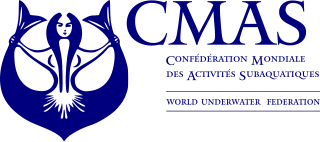
Confédération Mondiale des Activités Subaquatiques (CMAS) is an international federation that represents underwater activities in underwater sport and underwater sciences, and oversees an international system of recreational snorkel and scuba diver training and recognition. It is also known by its English name, the World Underwater Federation, and its Spanish name, Confederacion Mundial De Actividades Subacuaticas. Its foundation in Monaco during January 1959 makes it one of the world's oldest underwater diving organisations.

Bret Clifton Gilliam is a pioneering technical diver. He is most famous as the founder of TDI, and as the one time holder of the world record for deep diving on air. He is also one of diving's most popular writers.
Leigh Bishop is an explorer and deep sea diver known for his deep shipwreck exploration and still underwater photography.

Jonathan Bird is an American photographer, cinematographer, director and television host. He is best known for his role as the host of Jonathan Bird's Blue World, a family-friendly underwater exploration program on public television in the United States. His work is largely underwater in nature.
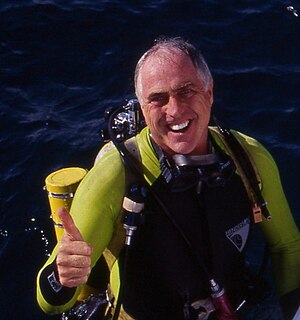
Bob Halstead, has made significant contributions to the sport of scuba diving in a multitude of capacities: photographer, author of eight diving books, early innovator in the development of dive tourism, pioneer in the dive liveaboard industry, diving instructor and educator, marine-life explorer and influential diving industry commentator. An ardent diver since 1968, Halstead has over 10,000 logged dives.

Jill Heinerth is a Canadian cave diver, underwater explorer, writer, photographer and film-maker. She has made TV series for PBS, National Geographic Channel and the BBC, consulted on movies for directors including James Cameron, written several books and produced documentaries including We Are Water and Ben's Vortex, about the disappearance of Ben McDaniel.
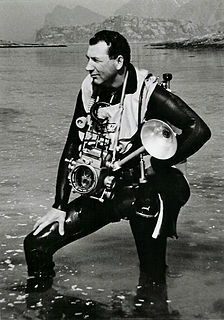
The history of scuba diving is closely linked with the history of scuba equipment. By the turn of the twentieth century, two basic architectures for underwater breathing apparatus had been pioneered; open-circuit surface supplied equipment where the diver's exhaled gas is vented directly into the water, and closed-circuit breathing apparatus where the diver's carbon dioxide is filtered from the exhaled breathing gas, which is then recirculated, and more gas added to replenish the oxygen content. Closed circuit equipment was more easily adapted to scuba in the absence of reliable, portable, and economical high pressure gas storage vessels. By the mid-twentieth century, high pressure cylinders were available and two systems for scuba had emerged: open-circuit scuba where the diver's exhaled breath is vented directly into the water, and closed-circuit scuba where the carbon dioxide is removed from the diver's exhaled breath which has oxygen added and is recirculated. Oxygen rebreathers are severely depth limited due to oxygen toxicity risk, which increases with depth, and the available systems for mixed gas rebreathers were fairly bulky and designed for use with diving helmets. The first commercially practical scuba rebreather was designed and built by the diving engineer Henry Fleuss in 1878, while working for Siebe Gorman in London. His self contained breathing apparatus consisted of a rubber mask connected to a breathing bag, with an estimated 50–60% oxygen supplied from a copper tank and carbon dioxide scrubbed by passing it through a bundle of rope yarn soaked in a solution of caustic potash. During the 1930s and all through World War II, the British, Italians and Germans developed and extensively used oxygen rebreathers to equip the first frogmen. In the U.S. Major Christian J. Lambertsen invented a free-swimming oxygen rebreather. In 1952 he patented a modification of his apparatus, this time named SCUBA, an acronym for "self-contained underwater breathing apparatus," which became the generic English word for autonomous breathing equipment for diving, and later for the activity using the equipment. After World War II, military frogmen continued to use rebreathers since they do not make bubbles which would give away the presence of the divers. The high percentage of oxygen used by these early rebreather systems limited the depth at which they could be used due to the risk of convulsions caused by acute oxygen toxicity.

The following outline is provided as an overview of and topical guide to underwater diving:

The following index is provided as an overview of and topical guide to underwater divers:
Catherine "Cathy" Church is an American marine biologist, SCUBA diver, underwater photographer and educator.